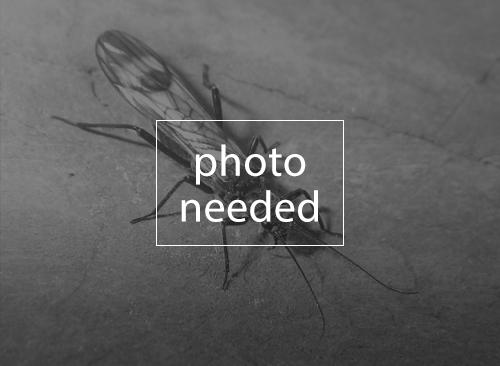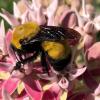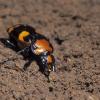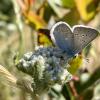
Hylaeus mana is a small bee endemic to the island of Oahu in Hawaii. It is distinguished by the extremely small size and narrow process of the 8th sternum of the male, and extensive facial marks of the female. It is known only from four specimens collected in 2002.
Males
Black, with the face largely yellow below the antennae, extending dorsally in a narrowing stripe; pronotum and legs extensively marked. Scape with a shallow groove underneath. Process of the 8th sternum narrow, not dilated. Very small, gracile.
Females
Face with three yellow lines, one against each eye and a transverse stripe at the apex of the clypeus. Other marks as in the male. Hylaeus mana is the smallest Hawaiian bee, a member of the dumetorum species group. The male is distinguished from related species by the 8th sternum and the small size, the female by the facial marks.
Taxonomic Status
Hylaeus mana was first collected in 2002 and described in Daly and Magnacca (2003).
Hylaeus mana probably inhabits lowland mesic forest. The only collection was on flowers of Santalum freycinetianum (iliahi, sandalwood). Nesting habits are unknown, but it probably nests in wood like related species.
Hylaeus mana is known only from one site in the leeward Koolau range of Oahu. The full range is unknown, but it is probably not large.
Xerces Red List Status: Critically Imperiled
Other Rankings:
Canada – Species at Risk Act: N/A
Canada – provincial status: N/A
Mexico: N/A
USA – Endangered Species Act: None
USA – state status: None
NatureServe: GNR
IUCN Red List: N/A
This species is extremely rare. However, it may be more abundant in the northern Koolau range, where native habitat is more intact.
The rarity of H. mana and lack of knowledge about its requirements make it difficult to assess threats. It is probably restricted to mesic forest; it was not found in wet forest along the same ridge. Mesic forest has been severely impacted by feral ungulates and invasive plants, and little remains compared to wet forest. However, the northern Koolau area has not been extensively searched for bees.
The top priority is to identify extant populations and document the continued existence of the species. The only known site for H. mana is in a state forest reserve. All areas where it is likely to be found are protected under the auspices of the State of Hawaii or the U.S. Army, though they may not be actively managed for habitat conservation. Research is needed in order to locate new populations, and to identify habitat requirements and reasons for rarity
Daly, H. V., and K. N. Magnacca. 2003. Insects of Hawaii, Vol. 17: Hawaiian Hylaeus (Nesoprosopis) Bees (Hymenoptera: Apoidea). University of Hawaii Press, Honolulu. 234 pp.
Citation
Magnacca, K. N. 2005. Species Profile: Hylaeus mana. In Shepherd, M. D., D. M. Vaughan, and S. H. Black (Eds). Red List of Pollinator Insects of North America. CD-ROM Version 1 (May 2005). Portland, OR: The Xerces Society for Invertebrate Conservation.
Profile prepared by Karl Magnacca, USGS-BRD, Kilauea Field Station





